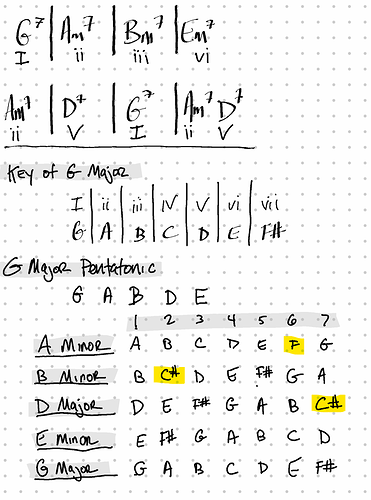I’ve been working on a lot of covers over the past year, and that’s been a lot of fun and I intend to continue with it.
That said, had my first “jam” with a buddy recently, and it highlighted the fact that in order to reach my musical goals, I need to be able to apply theoretical knowledge and to know what to play when I’m not simply playing something that’s already been written. This is exciting new ground!
For the next time we get together, we decided to take a more or less random jam track and work on it. So I started putting together a cheatsheet to focus myself, and I have a couple of questions.
First of all, it was cool to see how the notes of the pentatonic scale “work” for all the scales in the key. I kinda knew that, but it was cool to see it hold true when worked out on paper.
So anyway, the notes above are specific to the progression, so I don’t have the IV or the vii scales enumerated, as they aren’t used.
I noticed, though, that if I took the major/minor scales respectively for all the notes in the scale of G major, I end up with a few notes in those scales that are non-diatonic, which are highlighted in yellow.
Is this right, or am I looking at this wrong?
Next question, assuming this is right, should I avoid those notes? Granted, if I stick with roots and 5ths to start, even working in the respective major/minor thirds, I’ll not even run into these notes, which are 2nd, 6th, and 7th scale degrees respectively.
But in general, theoretically, is this the correct way of looking at it? I guess I was expecting all the notes of the scales would be diatonic and it surprised me to see otherwise. (Unless of course I did something wrong, still working to get my head around it.)


